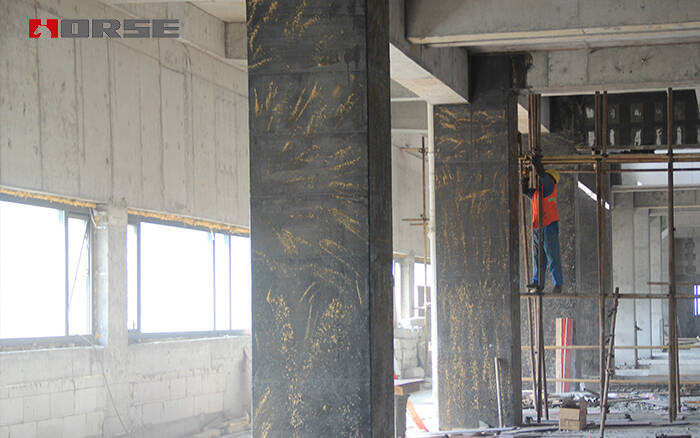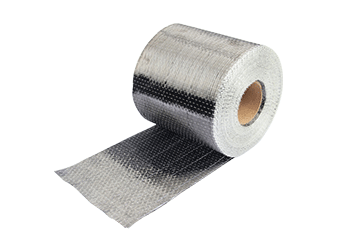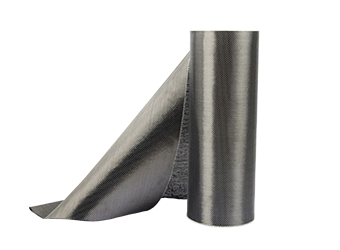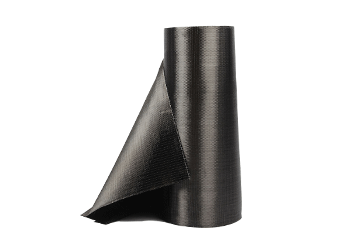Soluções
A Horse Construction oferece uma ampla gama de materiais de reforço estrutural, incluindo suporte técnico, suporte de documentação, suporte de produtos, suporte de software e suporte de projeto.
Column Strengthening With FRP

Structural requirements of FRP reinforced columns
1. The number of FRP sheet layers of circumferential bundle shall not be less than 2 layers for cylinder; Square and rectangular columns shall not be less than 3 layers.
2. The overlapping length between the upper and lower FRP sheet layers of the circumferential girth shall not be less than 50 mm, the extension length of the circumferential cutoff point shall not be less than 200 mm, and the overlapping positions of each strip shall be staggered.
3. The edges and corners of square and rectangular columns need to be chamfered. When carbon fiber and glass sheet are used for reinforcement, the chamfer radius should not be less than 25 mm.
4. The height of the densified area shall be the maximum of the dimension of the long side of the column section, 1/6 of the clear height of the column and 500mm.
5. It should be wrapped along the whole height of the column. For corner columns of seismic grade I and II, they shall be wrapped along the entire height of the column.

Mechanical properties of FRP
As we all know, the main stress direction of GRP is mainly parallel to the fiber direction, that is, the axial direction. Tensile strength, compressive strength and bonding performance are the main mechanical properties of FRP.
1 Tensile strength
Fiber is the basis of the tensile strength of GRP, and resin mainly plays an auxiliary role. Stress strain curves of fiber, resin and carbon fiber cloth. The stress-strain relationship of carbon fiber cloth is linear elastic. The ultimate strength of fiber is higher than that of frp. The ultimate tensile strain of resin is higher than that of FRP and fiber, which indicates that the resin breaks after the fiber breaks.
2 Compressive strength
The compressive strength of FRP is lower than the tensile strength. The compressive strength of GFRP, CFRP and AFRP is 55%, 78% and 22% of the tensile strength respectively. In most cases, the compressive strength of FRP is proportional to the tensile strength of FRP.
3 Adhesion property
The service performance and bearing capacity of the structure are affected by the bonding performance, and the FRP form, material performance, geometric size and FRP surface shape will affect the bonding performance.
Construction process of FRP reinforcement
• Surface treatment
• Applying HM-180 primer
• Repairing and leveling with HM-180CE leveling adhesive
• Applying HM-180C3P carbon fiber adhesive
• Externally bonded FRP
• Applying HM-180C3P carbon fiber adhesive again
• Curing and protecting
Você pode encontrar tudo o que precisa aqui. Confie e experimente esses produtos, você vai perceber uma grande diferença depois.

A fibra de carbono da Horse Construction é para reforço estrutural, reparo e modernização de substratos de concreto, alvenaria, aço e madeira em edifícios, pontes, rodovias, ferrovias, túneis, píeres e aeroportos civis.

Mantas de fibra de carbono unidirecionais Tecido de fibra de carbono unidirecional Mantas de fibra de carbono unidirecionais de alta resistência pré-saturadas para formar mantas de polímero reforçado com fibra de carbono (CFRP) usadas para reparar e forta

Mantas de fibra de carbono unidirecionais de alta resistência pré-saturadas para formar mantas de polímero reforçado com fibra de carbono (CFRP) usadas para reparar e fortalecer elementos estruturais de concreto.